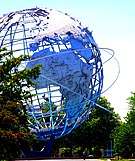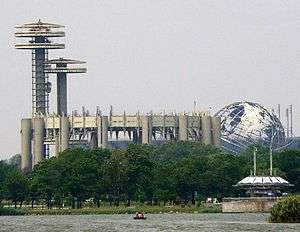Unisphere
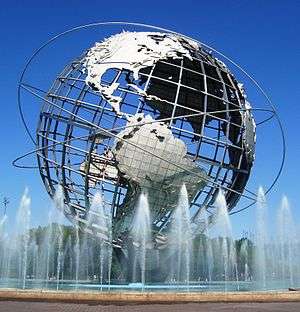
Coordinates: 40°44′47″N 73°50′41″W / 40.746426°N 73.844819°W
The Unisphere is a spherical stainless steel representation of the Earth, located in Flushing Meadows–Corona Park in the borough of Queens, New York City. The sphere, which measures 140 feet (43 m) high and 120 feet (37 m) in diameter, was commissioned as part of the 1964 New York World's Fair.[1] The Unisphere is one of the borough's most iconic and enduring symbols.
Commissioned to celebrate the beginning of the space age, the Unisphere was conceived and constructed as the theme symbol of the 1964–1965 New York World's Fair. The theme of the World's Fair was "Peace Through Understanding" and the Unisphere represented the theme of global interdependence. It was dedicated to "Man's Achievements on a Shrinking Globe in an Expanding Universe".
Construction
| Attractions and Geographical Features of Flushing Meadows–Corona Park |
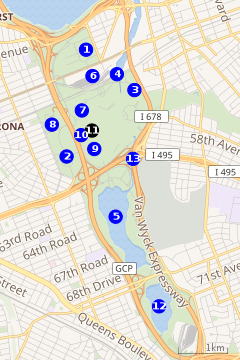 |
Attractions and geographical features of Flushing Meadows–Corona Park: 1 2 3 4 5 6 7 8 9 10 11 12 13 |

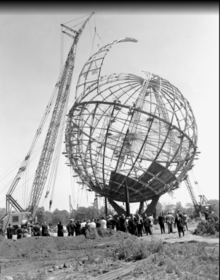
After World War II, Flushing Meadows–Corona Park reopened after having been closed for a long time, maintaining landscape architect Gilmore D. Clarke's site plan, as did the 1964 New York World's Fair, “Peace through Understanding."[1] Robert Moses was president of the World's Fair Corporation, which leased the park from the city and issued $29.8 million in bonds. The Unisphere was initially conceptually designed by the landscape architect in aluminum with metallic mesh continents; it underwent a further refined industrial design in stainless steel by industrial designers at Peter Muller-Munk Associates, and with engineering and fabrication by American Bridge Company, a division of US Steel. Built within 110 days,[3] the Unisphere is the world's largest globe. It measures 120 feet (37 m) in diameter, rises 140 feet (43 m), and weighs 700,000 pounds (317,515 kg), though some sources say the Unisphere weighs 900,000 pounds (408,233 kg), including its 100 short tons (91 t) inverted tripod base. The sphere is constructed of Type 304L stainless steel. The continents on the sphere are fabricated with a special texture-pattern by Rigidized Metals Corporation, based in Buffalo, New York.[4] Developed for this architectural project, the pattern's name of "1 UN" stands for "1 Unisphere."
During the 1964 fair, dramatic lighting at night gave the effect of sunrise moving over the surface of the globe. Additionally, the capitals of nations were marked by lights. One of these lights is placed at the location of the Kahnawake Indian Reservation, which the Mohawk ironworkers requested to be placed there to honor their labor.[5]
Built on the structural foundation that supported the Perisphere of the 1939 World's Fair, the Unisphere is centered in a large, circular reflecting pool and is surrounded by a series of water-jet fountains. The 96 fountainheads arranged in pairs are designed to obscure its tripod pedestal. The effect is meant to make the Unisphere appear as if it is floating in space.[6]
Three large orbit rings of stainless steel encircle the Unisphere at various angles. These orbit rings are believed to represent the tracks of Yuri Gagarin, the first man in space, John Glenn, the first American to orbit the Earth, and Telstar, the first active communications satellite. In fact, the early design was to have a ring for each of a dozen satellites in place at the time of the Fair. This proved impractical, not only in the number of satellites, but also in the height of their orbits and the fact that geostationary satellites had no orbit path. As a result, a symbolic number of three was chosen for aesthetic reasons.[7]
Rehabilitation
In 1989, the New York City Department of Parks and Recreation announced a multimillion-dollar rehabilitation of Flushing Meadows-Corona Park. Among the projects was a complete restoration of the Unisphere. Begun in late 1993 and completed on May 31, 1994, the project included numerous structural repairs and removal of years' worth of grime accumulation on the steel. The fountains, shut off since the 1970s, were replaced, and new floodlighting installed. On May 10, 1995, the Unisphere was given official landmark status by the New York City Landmarks Preservation Commission.[1]
The Unisphere's fountain reopened on August 12, 2010, after a $2 million restoration of its pumps, valves, and paintwork.[8] In addition, other sites say the globe and its surroundings, including its reflecting pool and fountains, were renovated at a cost of $3 million.[1]
Structural foundation
The marshy soil of Flushing Meadows needed special consideration during the original 1937 Perisphere construction for the 1939 World's Fair. The Perisphere, and subsequently the Unisphere, which used the same platform, employed a foundation of 528 pressure-creosoted Douglas fir piles of 95 to 100 feet (29 to 30 m) in length. Before construction of the Unisphere, three piles were tested for structural integrity and all were found to be sound throughout their entire length.[9]
In popular culture
The Unisphere was climbed in 1976 by George Willig (the so-called "Human Fly" who would later climb the World Trade Center), and Jerry Hewitt as part of a short film called The Third Stone, directed by NYU Film student, Paul Hornstein. Every year at least three people are taken to local hospitals for injuries from trying to climb the Unisphere.
The Beastie Boys, Depeche Mode, and The B-52's all have been photographed in front of the Unisphere for promotional purposes.[10]
A climactic scene in the movie Men in Black (1997) was set and filmed here. A crucial plot point in Iron Man 2 (2010) depended on the structure.
In season 6 of Law & Order: Criminal Intent an episode has the victim found under the Unisphere.[11]
The 1989 movie Black Rain begins with a shot of the Unisphere.[12]
Kevin James and Leah Remini appear at the Unisphere in the opening credits of American sitcom The King of Queens.
In Season 1 Episode 4 of Flight of the Conchords, Brett and Jermaine perform the song "If You're Into It" in front of the Unisphere.
In the 2008 video game Grand Theft Auto IV, the Unisphere appears in Liberty City as the Monoglobe in Meadows Park. It also appears in Grand Theft Auto: Chinatown Wars (2009), where it is destroyed in a mission by protagonist Huang Lee.
The Unisphere appears on the cover of Danger Danger's album Revolve.
The Unisphere appears in the music videos "Mo Money Mo Problems" by Notorious BIG and "Award Tour" by A Tribe Called Quest.
The Marvel Cinematic Universe movies Iron Man 2, Captain America: The First Avenger, and Spider-Man: Homecoming uses the Unisphere for the Stark Expo.
Similar globes elsewhere
A similar metal globe is at the front gate of Leisure World, Maryland.[13]
A similar globe is placed on the Constitution Avenue outside the Diplomatic Enclave in Islamabad, Pakistan
See also
References
- 1 2 3 4 The Encyclopedia of New York City (2). New Haven, US: Yale University Press. January 1, 2010. ISBN 9780300182576.
- ↑ "Unisphere (under construction)". NYPL Digital Collections. Retrieved November 13, 2016.
- ↑ "Unisphere, 1960 - Photos - New York: The 1960s". NY Daily News. Retrieved November 13, 2016.
- ↑ Focus on Fabrication - Rigidized Metals Archived February 26, 2014, at the Wayback Machine., The Architect's Newspaper 5.17.13
- ↑ "Unisphere: Built by US Steel as the symbol of the 1964-5 New York World's Fair", Place Matters, February 5, 2010, accessed January 11, 2011
- ↑ http://www.nyc.gov/html/lpc/downloads/pdf/reports/unisphere.pdf
- ↑ Short, Daniel (2016). Unisphere: Symbol of the 1964-1965 New York World's Fair (1st ed.). Arethusa Press. ISBN 978-0-692-50867-1.
- ↑ Hirshon, Nicholas (August 13, 2010). "Fountain's Return". New York Daily News. New York. Retrieved September 3, 2010.
- ↑ (Creosote) Performance: Proved By More Than 75 Years Service
- ↑ "The Unisphere". D Guides - New York City. D Guides. Retrieved April 17, 2017.
- ↑ http://www.tv.com/shows/law-order-criminal-intent/worlds-fair-937618/
- ↑ http://tvtropes.org/pmwiki/pmwiki.php/Film/BlackRain
- ↑ Von Eckardt, Wolf. "Senior Citizens' 'World' A Happy Change of Pace". The Washington Post. April 24, 1966. p. G7.
External links
| Wikimedia Commons has media related to Unisphere. |
- nywf64.com (1964/1965 New York World's Fair Web site) story of Unisphere at the World's Fair
- Unisphere Landmark Designation Report (PDF)
- Unisphere pictures
- Internet Archive: The Unisphere: Biggest World on Earth (1964), film about the creation of the Unisphere
- The Unisphere: Biggest World on Earth on Cinemaniacal
- Internet Archive: New York World's Fair, 1964/03/02 (1964), newsreel featuring the Unisphere.

